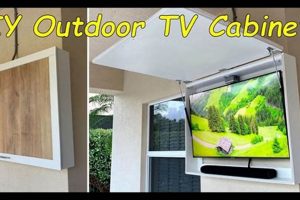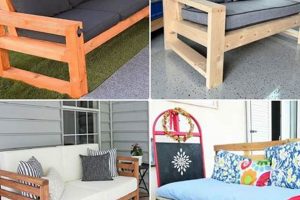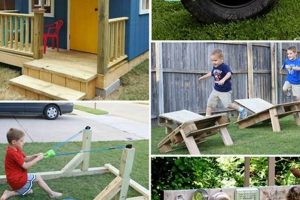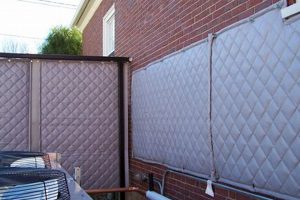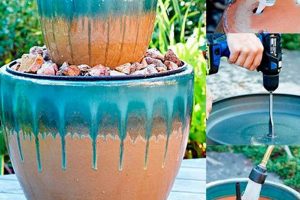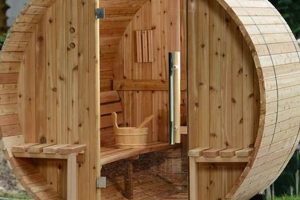A project involving the self-assembly or construction of a seating structure designed for external environments. These structures, typically providing seating for one or more individuals, are built using readily available materials and tools, often following instructions or designs found online or in print. For example, a homeowner might construct a wooden seat for placement on a patio, utilizing reclaimed lumber and basic carpentry skills.
The creation of these outdoor seating solutions offers several advantages. It provides a cost-effective alternative to purchasing pre-made furniture, allowing individuals to customize the design and materials to fit their specific needs and aesthetic preferences. Historically, crafting outdoor furniture has been a common practice, reflecting a desire for self-sufficiency and the efficient use of available resources. The practice continues to be relevant in contemporary society, driven by environmental consciousness and the increasing accessibility of project plans and building materials.
This discussion will now delve into the different types of materials suitable for this kind of outdoor project, the tools required for its successful completion, and some common design considerations to bear in mind.
Essential Guidelines for Outdoor Seating Construction
The following guidelines aim to improve the longevity and aesthetic appeal of self-constructed outdoor seating.
Tip 1: Material Selection is Paramount. Choose lumber treated for outdoor use, such as pressure-treated pine or cedar. These materials resist rot, insect infestation, and the adverse effects of moisture exposure. Untreated lumber degrades rapidly in outdoor environments, leading to structural failure.
Tip 2: Prioritize Proper Joinery Techniques. Employ robust joinery methods, such as mortise and tenon, dovetail, or properly executed screw connections with exterior-grade fasteners. Weak joints compromise the structural integrity of the seat, potentially resulting in collapse. Glue alone is insufficient for outdoor applications; mechanical fasteners are critical.
Tip 3: Implement Effective Drainage. Design the seat to facilitate water runoff. Angled surfaces and gaps between boards prevent water accumulation, which contributes to wood rot and deterioration. Consider incorporating small drainage holes in areas prone to water collection.
Tip 4: Apply a Protective Finish. Use a high-quality exterior-grade paint, stain, or sealant. These coatings protect the wood from UV radiation, moisture, and temperature fluctuations, extending the lifespan of the seat. Reapply the finish periodically to maintain optimal protection.
Tip 5: Consider Ergonomic Design. Ensure the seat height and backrest angle (if applicable) are comfortable for extended use. A seat that is too low or a backrest that offers inadequate support reduces user comfort and limits the seat’s usability.
Tip 6: Secure Placement. Place the finished structure on a level, stable surface. Uneven ground can place undue stress on the seat’s joints, leading to premature failure. Consider using concrete pavers or a gravel base to provide a stable foundation.
Tip 7: Regular Maintenance is Key. Inspect the structure regularly for signs of damage or wear. Tighten loose fasteners, repair cracks, and reapply the protective finish as needed. Promptly addressing minor issues prevents them from escalating into more significant problems.
Adhering to these guidelines ensures a durable, aesthetically pleasing, and functional outdoor seating structure.
The subsequent section will address common design styles and their practical implementation.
1. Material Durability
Material durability is a paramount consideration in the successful execution of any “diy bench outdoor” project. The selection of inappropriate materials will invariably lead to premature failure of the structure, regardless of the quality of the construction techniques employed. The causal relationship is direct: materials lacking inherent resistance to environmental factors will degrade, compromising the structural integrity and rendering the seating unusable. For example, utilizing untreated softwood in an outdoor setting exposes the wood to moisture, fungal growth, and insect infestation, resulting in rot and eventual collapse. Therefore, material durability forms the foundation upon which a functional and long-lasting outdoor seat structure is built.
The practical implications of understanding material durability are significant. Choosing durable materials such as pressure-treated lumber, redwood, cedar, or composite materials allows for the creation of seating that can withstand the rigors of outdoor exposure for extended periods. Each material offers varying degrees of resistance to specific environmental stressors. For instance, pressure-treated lumber resists decay due to chemical impregnation, while redwood and cedar contain natural oils that deter insects and retard rot. Composite materials, often made from recycled plastics and wood fibers, offer exceptional resistance to moisture and decay, requiring minimal maintenance. Selection should be based on budgetary constraints, aesthetic preferences, and anticipated environmental conditions.
In summary, material durability is not merely a desirable attribute, but a necessary prerequisite for a successful “diy bench outdoor” undertaking. The initial investment in appropriate materials translates to long-term cost savings by minimizing repair and replacement expenses. Ignoring this fundamental principle results in wasted time, resources, and ultimately, an unusable outdoor seating structure. Therefore, careful consideration of material properties and their resistance to environmental factors is critical for achieving a durable and aesthetically pleasing result.
2. Structural Integrity
The structural integrity of any outdoor seat structure is a critical determinant of its safety, longevity, and overall functionality. For a “diy bench outdoor” project, inadequate structural design or execution directly correlates with an increased risk of collapse or failure under load. This correlation highlights the indispensable role structural integrity plays in guaranteeing a safe and reliable seating solution. For example, a bench constructed with improperly joined components or undersized support members will inevitably succumb to the stresses of regular use and environmental factors, potentially causing injury to the user. Thus, structural integrity is not merely an aesthetic concern but a fundamental safety requirement.
Achieving sufficient structural integrity in an outdoor seat project necessitates careful consideration of several factors. Load-bearing capacity must be calculated based on the intended use and occupancy. The selection of appropriate joinery techniques, such as mortise and tenon, dovetail joints, or the use of structural screws, is paramount. Furthermore, the grain direction of the wood must be strategically aligned to maximize its strength and resistance to bending forces. For example, when constructing a seat with a significant span, reinforcing the underside with additional support beams or aprons can prevent sagging and ensure long-term stability. Practical application also involves the correct placement and securing of all components, ensuring even distribution of weight and minimizing stress concentrations.
In conclusion, structural integrity represents a non-negotiable element in the successful completion of an outdoor seating project. The challenges inherent in ensuring structural soundness underscore the need for a thorough understanding of basic engineering principles and carpentry techniques. A failure to prioritize structural integrity can lead to hazardous outcomes and the premature degradation of the seating structure. Therefore, a robust design, careful material selection, and precise execution are essential for achieving a safe and durable “diy bench outdoor”.
3. Weather Resistance
Weather resistance is a critical consideration in the context of any outdoor seating construction project. Structures designed for exterior use are subject to a range of environmental conditions that can degrade materials and compromise structural integrity. Effective strategies for mitigating these effects are essential for ensuring the longevity and safety of the seating.
- Material Selection
The choice of materials fundamentally influences the weather resistance of the structure. Naturally weather-resistant woods, such as cedar and redwood, contain oils that repel moisture and insects. Pressure-treated lumber undergoes a chemical process that inhibits decay. Synthetic materials, like recycled plastic lumber, offer superior resistance to moisture, insects, and UV degradation. Selecting the appropriate material based on climate and anticipated exposure is essential. For instance, in regions with high humidity and frequent rainfall, opting for a material with inherent resistance to rot and fungal growth is paramount. Conversely, areas with intense sun exposure require materials with UV-resistant properties to prevent fading and cracking.
- Protective Coatings
The application of protective coatings enhances the weather resistance of wood and metal components. Exterior-grade paints, stains, and sealants form a barrier against moisture penetration, UV radiation, and temperature fluctuations. These coatings also prevent the growth of mold and mildew, which can accelerate material degradation. Regular reapplication of these coatings is necessary to maintain their effectiveness. The specific type of coating should be selected based on the material and desired aesthetic. For example, a penetrating oil finish may be preferred for preserving the natural appearance of wood, while a solid-color paint provides maximum protection against the elements.
- Drainage Design
Effective drainage design is crucial for preventing water accumulation, which can lead to rot, corrosion, and structural damage. Designing seating surfaces with a slight slope allows water to run off freely. Incorporating gaps between boards or slats facilitates airflow and prevents moisture buildup. Furthermore, raised platforms or feet can elevate the seating structure above ground level, minimizing contact with standing water. In regions with heavy snowfall, designs that prevent snow accumulation are also important. For instance, open lattice structures or designs with minimal horizontal surfaces can reduce the risk of snow load causing structural failure.
- Hardware and Fasteners
The selection of corrosion-resistant hardware and fasteners is often overlooked but plays a key role in long-term durability. Using stainless steel, galvanized steel, or other corrosion-resistant materials prevents rusting and weakening of joints. Standard steel screws and nails will corrode quickly in outdoor environments, compromising structural integrity. The gauge and length of fasteners must also be appropriate for the materials being joined to ensure a strong and lasting connection. For example, when working with thicker lumber, longer screws or bolts are necessary to provide adequate holding power. Regular inspection and replacement of corroded hardware are essential for maintaining the structural integrity of the seating.
The facets discussed above, encompassing material selection, protective coatings, drainage design, and robust hardware choices, are inextricably linked to the successful creation of “diy bench outdoor” that withstands environmental challenges. Attending to each of these details during the design and construction phases is necessary to ensure a durable and aesthetically pleasing seating solution that can be enjoyed for years to come.
4. Ergonomic Design
The integration of ergonomic design principles into “diy bench outdoor” projects is not merely a cosmetic consideration, but a functional necessity for ensuring user comfort and promoting physical well-being. The absence of ergonomic considerations in outdoor seating design can lead to discomfort, strain, and potentially chronic musculoskeletal issues. An outdoor bench designed without proper seat height, back support, or armrests can induce poor posture, causing back pain, neck stiffness, and reduced circulation. Therefore, the cause-and-effect relationship between ergonomic design and user comfort is directly proportional; a well-designed bench promotes healthy posture and reduces physical strain, while a poorly designed bench leads to discomfort and potential health problems.
The practical application of ergonomic design to outdoor seating involves several key factors. Seat height should be appropriate for the average user, typically ranging from 16 to 18 inches, to allow for comfortable foot placement and proper leg circulation. Seat depth should also be considered to provide adequate support for the thighs. The inclusion of a backrest with a slight lumbar curve can significantly reduce strain on the lower back. Armrests, positioned at a comfortable height, can support the arms and shoulders, reducing tension in the upper body. Examples of ergonomic considerations include designing a bench with a slightly angled seat to promote natural pelvic alignment or incorporating rounded edges to prevent pressure points. These adaptations directly contribute to a more comfortable and supportive seating experience.
In conclusion, prioritizing ergonomic design in “diy bench outdoor” construction is essential for creating seating solutions that are not only aesthetically pleasing but also functionally beneficial. While challenges may arise in balancing ergonomic principles with design preferences and budget constraints, the long-term benefits of enhanced user comfort and improved physical well-being outweigh the initial investment. Understanding and implementing ergonomic principles in outdoor seating design is a key factor in ensuring the creation of a comfortable and supportive outdoor environment.
5. Aesthetic Integration
Aesthetic integration represents a crucial factor in the successful assimilation of a self-constructed outdoor seat structure into its intended environment. The extent to which the structure complements the surrounding landscape, architectural style, and existing decor directly impacts its overall visual appeal and contributes to a harmonious outdoor space. A structure that clashes with its surroundings, regardless of its structural integrity or ergonomic design, detracts from the aesthetic value of the property and may diminish the intended ambiance of the outdoor area. Thus, a cause-and-effect relationship exists between design choices and the visual impact on the surrounding area. The integration of aesthetic considerations into the design phase is, therefore, a fundamental component of a successful undertaking.
Achieving aesthetic integration involves several considerations. The choice of materials should align with the existing landscape and architectural style. For example, a rustic seat constructed from reclaimed wood may seamlessly blend into a garden setting, while a sleek, modern design with clean lines and metal accents may be more appropriate for a contemporary patio. Color palettes should complement the surrounding environment; natural wood tones and earthy colors often harmonize well with outdoor settings, while bolder colors can add a vibrant touch if used judiciously. Furthermore, the scale and proportions of the structure must be appropriate for the available space; an oversized bench may overwhelm a small patio, while an undersized bench may appear insignificant in a larger garden. Attention to detail, such as incorporating decorative elements or replicating design motifs from existing architectural features, can further enhance aesthetic integration.
In conclusion, aesthetic integration is not a superficial concern but an essential element in ensuring that a “diy bench outdoor” project enhances the overall aesthetic value of its surroundings. Overlooking this crucial aspect can result in a structure that feels out of place and detracts from the visual appeal of the outdoor space. Successfully integrating aesthetic considerations into the design and construction process requires careful planning, attention to detail, and a sensitivity to the existing environment. The reward for such diligence is a seating structure that is both functional and visually harmonious, contributing to a more inviting and enjoyable outdoor experience.
Frequently Asked Questions Regarding Outdoor Seating Construction
The following questions address common concerns and misconceptions encountered during the design and construction of outdoor seating structures. These responses aim to provide clarity and promote informed decision-making.
Question 1: What constitutes the primary factor determining the longevity of an outdoor seat?
The selection of appropriate materials forms the cornerstone of long-term durability. Untreated materials are inherently susceptible to degradation from moisture, sunlight, and biological agents. Pressure-treated lumber, naturally rot-resistant species like cedar, or composite materials are recommended for prolonged service life.
Question 2: How does proper drainage influence the integrity of an outdoor bench?
Effective drainage prevents water accumulation, a primary contributor to wood rot, corrosion, and structural weakening. Designs incorporating angled surfaces, gaps between boards, or elevated platforms facilitate water runoff and minimize moisture retention.
Question 3: What role does structural design play in ensuring a safe outdoor seating structure?
Sound structural design is paramount for preventing collapse or failure under load. Proper joinery techniques, appropriate material sizing, and adherence to load-bearing capacity calculations are essential for ensuring stability and user safety.
Question 4: Why is the application of a protective finish considered necessary for outdoor furniture?
Protective finishes, such as exterior-grade paints, stains, and sealants, act as a barrier against moisture penetration, ultraviolet radiation, and temperature fluctuations. These finishes prolong the lifespan of the materials and prevent premature degradation.
Question 5: In what ways does ergonomic design impact the functionality of an outdoor bench?
Ergonomic design contributes directly to user comfort and reduces the risk of strain or injury. Appropriate seat height, back support, and armrest placement promote proper posture and minimize physical stress during extended use.
Question 6: How does aesthetic integration contribute to the overall value of an outdoor seating project?
Aesthetic integration ensures that the seating structure complements its surroundings and enhances the visual appeal of the outdoor space. Harmonizing material choices, color palettes, and design motifs with the existing landscape and architectural style creates a cohesive and inviting environment.
In summation, the successful completion of an outdoor seating project hinges on a comprehensive understanding of material properties, structural principles, weather resistance strategies, ergonomic considerations, and aesthetic integration techniques. Neglecting any of these factors can compromise the functionality, longevity, and overall value of the resulting structure.
The succeeding section will explore cost-effective strategies for implementing the above principles.
Conclusion
This discussion has comprehensively explored the key aspects of constructing a seat structure for outdoor use. From material selection and structural integrity to weather resistance, ergonomic design, and aesthetic integration, the principles outlined serve as a guide for creating durable, functional, and visually appealing seating solutions. The presented information underscores the importance of careful planning and execution in ensuring a successful outcome.
The self-construction of outdoor seating presents an opportunity to create customized solutions tailored to specific needs and aesthetic preferences. While challenges may arise, adherence to established best practices will yield a long-lasting and valuable addition to any outdoor space. Continued research and refinement of these techniques will further enhance the accessibility and effectiveness of self-built outdoor furniture.


